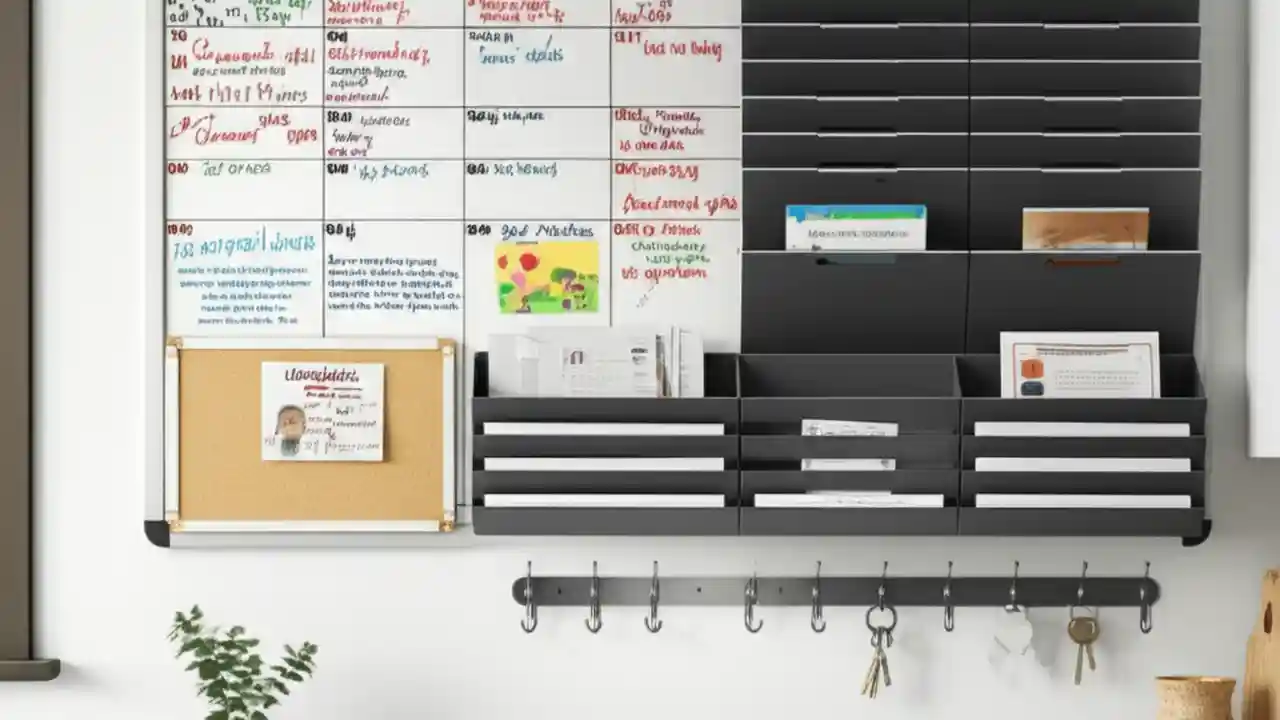The easiest way to get a more organized car is to embrace two core principles: creating designated “zones” for everything and adopting the “one-touch rule” to prevent clutter from building up in the first place. Think of your car not as one big space, but as a series of small, functional areas, each with a specific purpose. This simple shift in mindset is the foundation for lasting order on the road.
As someone who has helped people declutter every part of their lives for 20 years, I’ve seen that the car is often the final frontier of chaos. It’s a transitional space where things get dropped and forgotten. But it doesn’t have to be that way. Getting your car organized isn’t about buying a dozen expensive gadgets; it’s about creating simple, sustainable systems.
In this comprehensive guide, we’ll go far beyond a simple checklist. We’ll explore quick 5-minute fixes, create a bulletproof system for keeping your car tidy long-term, and dive into the best car organization ideas for every situation, from daily commutes to road trips with the entire family. Let’s transform your car from a source of stress into a sanctuary of calm.
Table of Contents
The Foundation: Quick Wins & Daily Habits
Lasting organization is built on small, consistent actions. Before you buy a single container, focus on establishing these foundational habits. They take minimal effort but deliver maximum impact, preventing the clutter from ever taking hold.
What’s the fastest way to make my car feel more organized?
The “15-Minute Reset” is your best friend. Don’t try to tackle everything at once. Just set a timer for 15 minutes and focus on high-impact tasks. You’ll be shocked at what you can accomplish.
Here’s a simple plan to follow:
- Trash Out (5 minutes): Grab a trash bag and work your way from the front to the back. Collect all the obvious garbage—old receipts, food wrappers, empty bottles, and junk mail. Don’t sort, just toss.
- Belongings Back (5 minutes): Grab a basket or a reusable bag. Go through the car again and collect everything that doesn’t belong there: toys, clothes, mail, coffee mugs, random items from your pockets. Take the basket inside and put everything away in its proper home. This step is crucial.
- Surface Wipe (3 minutes): Use a microfiber cloth or an interior detailing wipe to quickly clean the dashboard, steering wheel, gear shift, and door handles. A clean surface instantly makes the entire space feel more put-together.
- Floor Mat Shake (2 minutes): Pull out the front floor mats, give them a vigorous shake, and put them back. This removes a surprising amount of dirt and debris and makes a huge visual difference.
Doing this once a week will prevent 90% of the clutter and grime that makes a car feel messy.
How can I maintain car organization daily?
This is where the magic happens. Two simple habits will change everything: the “Touch It Once” Rule and the “Exit Sweep.”
The “Touch It Once” Rule: When you bring something into your car, decide its fate immediately. Mail? It goes into a designated folder, not the passenger seat. Coffee cup? It goes in the cup holder. The goal is to avoid setting things down “for now,” because “for now” often becomes forever.
The “Exit Sweep”: This is non-negotiable. Every single time you get out of your car at home, take something with you. Even if it’s just one coffee cup or a piece of mail. It’s a tiny habit that takes five seconds but prevents items from accumulating. I tell my clients to link this habit to unbuckling their seatbelt. Buckle clicks, brain says “What can I take with me?”
What’s the best system for managing trash in a car?
A flimsy plastic bag from the grocery store is not a trash can; it’s a future mess. The key is to have a dedicated, structured trash receptacle that’s easy to access and empty.
Look for a small, waterproof car trash can that can hang from the back of a seat, the gear shift, or sit in the footwell. The best ones have a lid to keep garbage out of sight and contain odors. I personally prefer the hanging models as they don’t take up valuable floor space.
Pro Tip: Line your car trash can with small liners or reuse plastic grocery bags. When it’s full, you just pull the liner out and toss it. Empty it every time you fill up with gas. This links the task to an existing routine, making it almost automatic.
Strategic Zones: A Place for Everything
Now that you have the habits down, it’s time to get strategic. “Zoning” is the practice of assigning a specific purpose to every storage area in your car. No more random stuffing. Every item has a home.
How should I organize my glove compartment and center console?
These two areas are prime real estate but often become black holes of clutter. The solution is compartmentalization.
Glove Compartment Zone: This is for “Car-Specific Paperwork & Manuals.”
- Use a small, flat document holder or accordion file.
- Label sections for: Insurance Card, Vehicle Registration, Owner’s Manual, and a list of emergency contacts.
- Add a tire pressure gauge and a small notepad and pen. That’s it. Everything else should be moved.
Center Console Zone: This is for “Driver’s Reachable Essentials.”
- Use a drop-in console organizer tray. Many are made for specific car models and fit perfectly.
- This is home for your sunglasses, charging cables (use short ones or cable ties to keep them neat), lip balm, hand sanitizer, and a small stash of mints or gum.
- Loose change goes into a small, dedicated container like an old film canister or a mini pill bottle.
What are the essentials I should always keep in my car?
I recommend creating two distinct kits: an Everyday Kit and an Emergency Kit. This prevents you from having to dig through emergency gear to find a tissue.
| Kit Type | Location | Contents |
|---|---|---|
| Everyday Kit | Seat-back organizer or a small bin in the passenger footwell | Tissues, wet wipes, a small first-aid kit (band-aids, pain reliever), a phone charging bank, a reusable shopping bag, a small snack like a granola bar. |
| Emergency Kit | A dedicated duffel or bin in the trunk | Jumper cables, a flashlight with extra batteries, a basic toolkit, a blanket, a rain poncho, a high-visibility vest, non-perishable snacks, and bottled water. |
Check and restock these kits twice a year when you change your clocks for daylight saving time. It’s an easy way to remember.
How do I effectively organize my car trunk?
The trunk should be zoned just like the cabin. The goal is to keep the floor clear and secure your items to prevent them from rolling around.
- Empty and Clean: Start by taking everything out. You’ll be surprised what you find. Vacuum the entire space.
- Install an Organizer: A collapsible, multi-compartment trunk organizer is one of the best investments you can make. It contains groceries, sports equipment, and your emergency kit perfectly. Look for one with non-slip bottoms.
- Create Zones:
- Zone 1 (Emergency): Place your Emergency Kit in one of the far corners, where it’s accessible but out of the way.
- Zone 2 (Regulars): Use the trunk organizer for things you carry often, like grocery bags, a blanket for the park, or kids’ sports gear.
- Zone 3 (Flex Space): Leave the largest area of the trunk floor open for temporary, bulky items like luggage, strollers, or a big grocery run.
- Use Vertical Space: Look into cargo nets or hanging trunk organizers that attach to the back of the rear seats. These are fantastic for smaller, lighter items like cleaning supplies, umbrellas, or ice scrapers.
Taming the Chaos: Family & Pet-Specific Solutions
Adding kids or pets to the mix introduces new organizational challenges. The key here is accessibility and containment. Make it easy for them to access what they need and easy for you to clean up what they leave behind.
What are the best car organization ideas for families with kids?
As a parent, I know the struggle is real. The secret is to empower kids with their own “stations” while protecting your car’s interior.
- Backseat Command Center: A good seat-back organizer is non-negotiable. Look for one with a clear tablet holder, insulated pockets for drinks, and various mesh pockets for books, small toys, and art supplies. Each child should have their own.
- The Snack Station: Designate a specific, easy-to-clean container for car-friendly snacks. I use a small plastic tackle box or a bento-style box. It prevents crushed crackers and rogue gummies. Rule: snacks stay in the box.
- The Activity Caddy: For longer trips, use a small, portable shower caddy. Fill it with crayons, coloring books, and small games. It’s easy to carry in and out of the car and keeps everything contained on their lap.
- Waterproof Seat Covers: This is more of a preventative measure, but it’s the single best thing you can do for your sanity. They protect against spills, mud, and melted crayons.
How do I keep my car clean and organized with dogs?
Our four-legged friends bring joy, and a lot of hair and dirt. Organization for pets is about protection and preparation.
A “Go Bag” for your pup is a game-changer. Keep a dedicated tote bag in the trunk with all their essentials:
- A collapsible water bowl and a bottle of water
- A leash and waste bags
- A few favorite toys
- A towel specifically for muddy paws
- A small stash of treats
For protecting your car, a hammock-style, waterproof seat cover for the back seat is essential. It not only protects the seat from hair and scratches but also prevents your dog from falling into the footwell. It contains the mess to one easy-to-clean area.
Smart Products & DIY Hacks: What Actually Works?
The market is flooded with car gadgets. Some are brilliant, while others are just more clutter. Here’s how to tell the difference and even make your own solutions.
Are expensive car organizers really worth the money?
Sometimes, but not always. The value isn’t in the price tag; it’s in the design and material. An expensive, poorly designed organizer is worse than a cheap, effective one.
I’ve found that spending a little more on a few key items pays off in durability and functionality. A well-made, sturdy trunk organizer or a waterproof seat cover will outlast cheaper alternatives and work better, saving you money and frustration in the long run. However, for smaller tasks, simple DIY solutions are often superior.
What are some clever DIY car organization hacks?
You don’t need to spend a lot of money. Some of the best solutions are hiding in your home right now.
- Silicone Cupcake Liners: Place these in your cup holders. They catch crumbs and sticky drips, and you can just pop them out and wash them in the dishwasher.
- Remote Control Caddy: A small, fabric remote control caddy, the kind you hang over an armchair, can be wedged between the passenger seat and the center console. It creates instant pockets for phones, notepads, and snacks.
- Cereal Container Trash Can: A large, plastic cereal container with a pop-top lid makes a fantastic, spill-proof trash can that fits neatly on the floor or a seat.
- Carabiner Clips: Hook a carabiner clip to the passenger seat headrest post. It’s a perfect, sturdy hook for a purse, backpack, or grocery bags to keep them from spilling on the floor.
What key features should I look for in a car organizer?
When you do decide to buy, don’t be swayed by marketing. Focus on the features that matter for long-term use and effectiveness. Here’s a quick comparison of what to look for in three common types of organizers.
| Organizer Type | Key Feature #1 | Key Feature #2 | Key Feature #3 |
|---|---|---|---|
| Trunk Organizer | Collapsibility: Can it be folded down to save space when not in use? | Non-Slip Bottom: Does it have rubber feet or Velcro strips to prevent sliding? | Rigid Walls: Are the dividers and outer walls sturdy enough to stand up on their own? |
| Seat-Back Organizer | Adjustable Straps: Does it have top and bottom straps to secure it tightly against the seat? | Durable, Wipeable Material: Is it made of a material like 600D polyester that can withstand kicking and spills? | Functional Pockets: Are the pockets a useful size? (e.g., insulated for drinks, clear for tablets). |
| Visor Organizer | Secure Straps: Does it use strong, wide elastic or Velcro straps that won’t stretch out? | Slim Profile: Will it hold items without obstructing your view or preventing the visor from closing? | Logical Layout: Does it have smartly placed slots for sunglasses, cards, and pens without being bulky? |
The Deep Clean: A Seasonal Reset for Lasting Order
Even with great daily habits, every car needs a periodic deep clean and reorganization. I recommend doing this four times a year, at the start of each season. This allows you to adjust your car’s contents for the weather ahead (e.g., adding an ice scraper in fall, sunscreen in spring).
How do I perform a full car declutter and organization?
Set aside about an hour and follow these steps for a total reset.
- The Purge: Take EVERYTHING out of your car’s cabin and trunk. Everything. Sort items into three piles: Keep in Car, Relocate to House, and Trash/Recycle. Be ruthless.
- The Deep Clean: With the car empty, give it a thorough vacuuming. Wipe down all hard surfaces—dashboard, doors, console. Clean the inside of the windows. This is the best time to wash your floor mats.
- The Re-Zoning: Look at your “Keep in Car” pile. Re-evaluate your zones. Is your current system working? Now is the time to adjust. Maybe the first-aid kit is better in the glove box, or the reusable bags are better in a seat-back pocket.
- The Reload: Put items back into the car, but only into their newly assigned zones. Use the containers and organizers you have. This is also when you’ll identify if you truly need a new organizational product.
- The Seasonal Swap: Add in any seasonal items needed (ice scraper, beach towel, etc.) and remove items from the previous season.
How often should I fully clean out and reorganize my car?
A full, one-hour deep clean and reorganization is ideal seasonally, or about four times a year. This keeps clutter from reaching overwhelming levels and ensures your emergency supplies are up to date.
However, the 15-Minute Reset should be done weekly, and the “Exit Sweep” should be done daily. It’s this combination of daily maintenance, weekly tidying, and seasonal resets that creates a car that is, and stays, effortlessly organized.
Conclusion
Creating and maintaining an organized car isn’t about achieving perfection; it’s about reducing stress and making your daily life easier. By implementing simple habits like the “Exit Sweep,” creating smart zones for your essentials, and using the right tools for your specific needs, you can transform your vehicle from a chaotic catch-all into a calm, functional space. Remember the core idea: a designated home for everything and a simple routine to keep it there. Start with one tip today—like the 15-minute reset—and build from there. You’ve got this!







